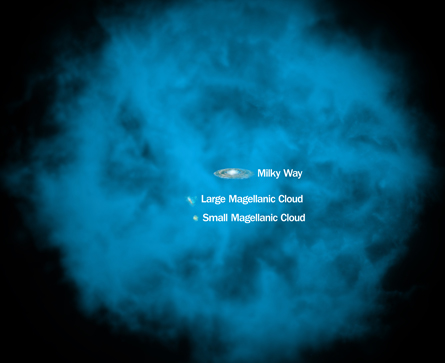Atom & Cosmos
The gassy halo engulfing the Milky Way, a comet in the neighborhood, and extraterrestrial rocks as the source of life on Earth
Huge halo may hold missing matter
The Milky Way galaxy is cocooned inside an enormous cloud of hot gas, a finding that could solve a persistent astrophysical conundrum. Heated to more than 1 million degrees Celsius, the halo extends more than 300,000 light-years from the galactic center and contains at least as much mass as 10 billion suns, scientists report in the Sept. 1 Astrophysical Journal Letters. An international team of astronomers used NASA’s orbiting Chandra X-ray Observatory to detect hot, charged oxygen atoms. If verified, the halo’s size could solve what’s been called the “missing baryon” problem: In the Milky Way and local neighborhood, at least half the expected baryons — normal subatomic particles like protons and neutrons — are unaccounted for. Now, scientists think these particles might be hiding in this and other superhot, gassy halos. — Nadia Drake

Comet could dazzle or fizzle
The skies might blaze with a visitor shining more brightly than the moon beginning in November 2013. A large comet, called C/2012 S1, was discovered September 21 by the International Scientific Optical Network in Russia and confirmed September 24 by the International Astronomical Union’s Minor Planet Center in Cambridge, Mass. Also called Comet ISON, the icy traveler is currently outside the orbit of Jupiter and in the constellation Cancer, heading for a close encounter with the sun. As it whizzes by the sun, the comet’s frozen ingredients could evaporate and leave behind a long, spectacular tail — if it doesn’t begin breaking up before then. Though predicting cometary orbits is easy, predicting brightness is trickier, because that depends on how a comet behaves. Comet ISON has the potential to be the brightest observed from Earth in a century, “or it could fizzle,” writes amateur astronomer Bill Gray in a guest blog post for the Planetary Society. — Nadia Drake
Neighbors may have lent life
Life could have been brought to Earth aboard rocky chunks ejected from neighboring planetary systems. The idea, called lithopanspermia, is often viewed with derision or incredulity — but conditions in the early solar system may have been just right for such a thing to occur, Amaya Moro-Martín of Spain’s Centro de Astrobiología reported at the European Planetary Science Congress in Barcelona on September 25. After considering the dynamic environment in the very young solar system and its proximity to neighboring planetary systems, Moro-Martín and colleagues concluded that life-bearing materials could be efficiently exchanged between systems if interstellar rocks traveled at slow speeds. In a related paper published September 12 in Astrobiology, the team calculates that more than a trillion rocks heavier than 10 kilograms could have traveled between the sun and its neighbors before the sun’s native star cluster dispersed. — Nadia Drake







